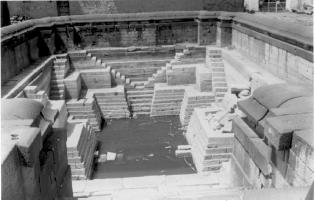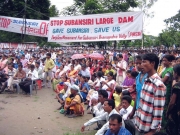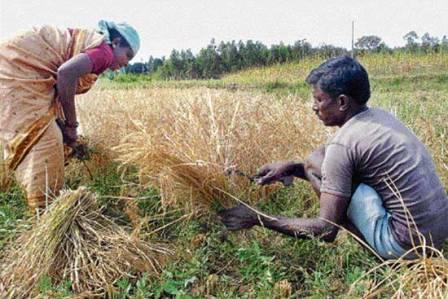/sub-categories/information-education-and-communication-campaigns
Information, Education and Communication Campaigns
Apotheosis of water and its inevitability in Indian culture - Paper presented at the National Seminar on Water and Culture (2007)
Posted on 09 Jan, 2011 11:23 PMThis paper highlights the role and value of water in ancient times. The author begins with analysing the discussion on water in the Rig Veda and it's deification. The paper points out to the link between various Hindu gods and water. Social mores in the context of water use is also highlighted, taboos like no nude bathing in rivers and no excretion into such water bodies is pointed out.
Sanitation is sexy challenge : Winners announced
Posted on 07 Jan, 2011 10:54 AMArticle and Image Courtesy: Acumen Fund
Author: James Wu
 The judges votes are in, and we’re excited to announce the winners for the Search for the Obvious Sanitation is Sexy challenge.
The judges votes are in, and we’re excited to announce the winners for the Search for the Obvious Sanitation is Sexy challenge.
Benchmarking local government performance on rural sanitation in Himachal Pradesh - A learning note by WSP
Posted on 06 Jan, 2011 06:43 AMThis document deals with benchmarking local government performance on rural sanitation in Himachal Pradesh. To strengthen outcome-focused management of the rural sanitation sector in India, the Water and Sanitation Program’s (WSP) Global Scaling Up Sanitation Project, in partnership with the Government of Himachal Pradesh, developed a five-step process to monitor and benchmark performance on a monthly basis across all twelve districts in the state. Applied at the local government (district) level, this process has proven to be an effective approach, one that can improve reporting, monitoring, and performance.
Maharashtra Groundwater (Development and Management) Bill (2009)
Posted on 05 Jan, 2011 07:32 PMThe Maharashtra Groundwater (Development and Management) Bill, 2009 aims to facilitate and ensure sustainable and adequate supply of groundwater of prescribed quality, for various category of users, through supply and demand management measures, protecting public drinking water sources and to establish the State Groundwater Authority and District Level Authorities to manage and to regulate, with community participation, the exploitation of groundwater within the State of Maharashtra.
Civil society consultations for the 12th Five Year Plan Approach Paper: Urban & Rural WATSAN sector
Posted on 30 Dec, 2010 11:20 AMAt the request of the Planning Commission, Arghyam and WaterAid agreed to co-ordinate and support a process of civil society consultation for inputs on rural and urban domestic water and sanitation for generating recommendations for the Approach Paper to the 12th Five Year Plan of the Government of India.
A glimpse of the audience
Influence of Chalukya architecture on Hampi stepwell - Paper presented at the National Seminar on Water and Culture (2007)
Posted on 29 Dec, 2010 04:16 PM
This paper discusses the reasons for building tanks in ancient India and mentions ancient texts like 'Samarangan Sutradhar' to indicate how wells and other water bodies were constructed.
These water storage systems indicate the knowledge of geology, soil engineering, construction engineering and structural engineering in ancient times.
Droplets: e-Newsletter from Everything About Water - December 2010
Posted on 29 Dec, 2010 10:56 AMArticle and Image Courtesy: Everything About Water
The December edition of Droplets e-newsletter published by the Everything About Water had the following highlights:
Damming North East India - Juggernaut of hydropower projects threatens social and environmental security of region
Posted on 28 Dec, 2010 07:49 PM This report by Kalpavriksh, Aaranyak and ActionAid India deals with the large dams’ juggernaut, which happens to be the biggest ‘development’ intervention in this ecologically and geologically fragile, seismically active and culturally sensitive region in the coming days. With the Northeast identified as India’s ‘future powerhouse’ and at least 168 large hydroelectric projects set to majorly alter the riverscape, large dams are emerging as a major issue of conflict in the region.
This report by Kalpavriksh, Aaranyak and ActionAid India deals with the large dams’ juggernaut, which happens to be the biggest ‘development’ intervention in this ecologically and geologically fragile, seismically active and culturally sensitive region in the coming days. With the Northeast identified as India’s ‘future powerhouse’ and at least 168 large hydroelectric projects set to majorly alter the riverscape, large dams are emerging as a major issue of conflict in the region.
Although the current scale of dam-related developments far outstrips anything which took place in the past, the region has been no stranger to dam-related conflicts. For example, the Kaptai dam, built in the Chittagong Hill Tracts of East Pakistan (now Bangladesh) in the 1960s, submerged the traditional homelands of the Hajong and Chakma indigenous communities, and forced them to migrate into parts of Northeast India.
High altitude wetland protected areas in western Arunachal Pradesh - Identification and demarcation using GIS
Posted on 27 Dec, 2010 11:15 PMGuest Post by Shashank Srinivasan
High altitude wetlands in the Indian Himalayas are crucial to the water security of downstream communities. They buffer the flow of glacial meltwater to sustain river flow in the dry season, ensuring that human settlements have access to water when they need it most.
High altitude wetlands are also reservoirs of biodiversity and contribute local livelihood opportunities. Identifying these wetlands and demarcating areas for their protection is thus crucial to any wetland management plan.
In this poster, a method of using topographic data obtained by remote sensing techniques, to identify the catchment areas of these wetlands has been described.
The author suggests that the protection of these catchment areas will ensure the survival of these wetlands, as well as of the communities that depend on them.
Water management lessons from the Nandi foothills - SRI technique involves less water
Posted on 27 Dec, 2010 11:10 AM This has resulted in a depletion of groundwater resources. There is a scarcity of drinking water too, in the region.
This has resulted in a depletion of groundwater resources. There is a scarcity of drinking water too, in the region.